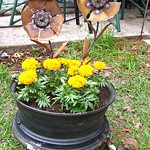Most of the rubber that is recycled comes from automobile and truck tires. The EPA says that over 300 million tires are disposed of in America every year. If they end up in a landfill they cause problems because of their bulk and their void space. The empty area inside can trap and hold methane gas that is supposed to be collected and vented out of the landfill. Air or methane inside causes the tires to “bubble” up through the landfill composition. They can also damage the liners placed in some areas of a landfill to prevent ground water contamination.
Tires that are stockpiled or dumped illegally create an eyesore and a breeding ground for mosquitoes and disease carrying vermin. Tire fires can occur easily: burning for months and creating substantial pollution in the air and ground.
Tires account for most of the rubber available for recycling, but not all of it. Shoes, especially sports shoes, often have rubber soles. Rubber is used in construction materials, floor mats for home, industry and automobiles, and inner tubes for bicycles, trailer tires, hand trucks, wagons, etc.
How is Rubber Recycled?
There are basically three methods of recycling rubber.
Refurbishing
Refurbishing a rubber product, like a tire, is to replace the worn parts with new to make the product useable again. A tire that has worn tread but a good carcass and bead can re re-treaded to make a usable tire at much lower cost. This is a common practice for over-the-road trucks because their tires are quite expensive. Retread tires are exported in bulk to Mexico and other countries where lower cost tire alternatives are in high demand. Some shoes can be re-shod, though most people don’t bother any more.
Grinding
Rubber products can be run through a grinding apparatus that shreds the product into small pieces that will be used as-is for other purposes. When shredding tires, provisions must be made to remove steel and fiberglass from the shredded rubber to eliminate safety hazards to consumers using the shredded rubber product.
Some use a purely mechanical process, some use liquid nitrogen to freeze the rubber to a crystalline state which can be shattered with a hammering device. This generally produces rubber with fewer contaminants to be removed.
Devulcanization
Most rubber products are made using a process called vulcanization which uses heat to rearrange the molecules in the natural rubber to increase its elasticity and durability. Because it is vulcanized, rubber cannot be simply melted down and recast into something else like some plastics, glass, and most metals can. To be used in this manner, the rubber must first be devulcanized: a process that involves very high heat and some highly toxic chemicals. The process is considered so environmentally unfriendly that its use is highly discouraged. Research continues for a means of making rubber reusable in a more responsible way.
What is made from Recycled Rubber?
Recycled rubber can be simply ground up to make products such as rubber mulch for use in gardens and as a loose playground surface instead of pea gravel. Like mulch make from ground wood, the rubber mulch aids in retaining ground moisture, helps prevent weeds, and can be dyed a variety of colors to make it attractive. Rubber mulch does not break down, so it doesn’t have to be replaced, as wood mulch will. Rubber mulch also does not attract termites, ants and bees as wood mulch can. Because it does not break down, rubber mulch will not, however, enrich your soil.
Granulated rubber can be pressed into a variety of shapes to become new products such as parking lot curb blocks.
Granulated rubber can also be processed into flooring tiles, mats and sheets that offer a durable, shock absorbing surface for gymnasiums, health clubs, industrial work stations, and homes.
Rubber is being used increasingly as the surface of running tracks.
Pelletized rubber can also be added to asphalt and used as a road or driveway pavement.
Tires can be used as fuel by burning them in industrial applications and power plants.
Tires can also be directly converted into new products my simply punch-stamping the tread or sidewalls to create shapes used in other ways.
Why Recycle Rubber?
As mentioned above, disposing of tires (legally or illegally) creates a number of environmental issues. Reclaiming and recycling rubber uses less energy than producing new rubber. Additionally, recycling rubber reduces demand for new natural rubber, which helps keep rubber tree plantations from expanding into sensitive tropical ecosystems.
How to Recycle Rubber
These days most tire dealers will accept and recycle your old tires when you buy new ones. There is a small processing fee associated, but it saves you from having to haul them off to a recycler. If you are disposing of old tires, your local county convenience centers generally accept them and will send them off for recycling. Or you can search for local businesses or artists that use old tires by stamping or cutting them into parts for their product. They may even buy them from you!
Some shoe manufacturers are engaging in a shoe take-back program where they offer you a discount on a new pair when you bring back the old ones for recycling.
If you have large rubber items like floor mats, check with your local waste management service. Most will accept these and send them off with the tires to be recycled.
Summary
Recycling rubber products – especially tires – reduces bulk in landfills, reduces potential contamination and damage to landfills. Using recycled rubber reduces the cost and energy consumption of producing products from new rubber and holds down demand for virgin rubber that would endanger rainforest environments.
- Recycling tires helps eliminate health hazards that come from mosquitoes and vermin that will breed in them.
- Recycling rubber is convenient.
- Recycling rubber helps create an array of useful new products.
- Please, recycle your unwanted rubber products.
References
What are clouds made of? They’re mostly air and water in some form or another. Generally this would be water vapor. Think of it as cold steam. The droplets are so tiny, they can ride eddies and currents of air that constantly swirl about in our atmosphere. Dry air is also denser than water vapor, so it will buoy the clouds up until the vapor turns to larger droplets (rain) or freeze into snow or hail.













